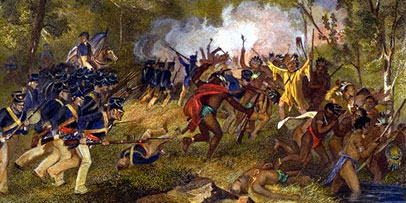Hostilities on the Frontier
While President Madison searched in vain for a solution to the British and French problem, a new wave of hostilities flared up in the western settlements. White settlers had continued to move west during the first decade of the 1800s. Jefferson, ever supportive of the American farmer, believed the Native Americans should assimilate into white agricultural communities or move west of the Mississippi. Unlike descendents of Africans, Jefferson believed Native Americans had the intelligence and temperament to mix blood with whites. To pursue assimilation, his administration did not recognize tribal claims to hunting grounds in the Northwest Territory.

Madison continued the Republican Native American policy begun under Jefferson. Whites moved west in waves, forcing Native Americans to give up their culture, land, and independence. Some Native Americans tried to stand against the tide beating against them. In the early 1800s, a Shawnee shaman, called “the Prophet,” sparked a religious revival among Native Americans. The Prophet encouraged Native Americans to cut commercial ties with whites, end land sales, and return to a purer way of life.
The Prophet's brother, the Shawnee chief Tecumseh, believed that a military movement, not a spiritual revival, was necessary for the survival of his people. Urging Native American tribes to set aside their differences with each other, Tecumseh called for tribes in the Mississippi Valley to unite. Though the prosperous tribes of the South expressed reluctance, many tribes in the Northwest Territory, who were under pressure from whites moving west, joined Tecumseh's confederacy. They presented a formidable barrier to white settlement and it was not entirely clear who would win a widespread conflict. Britain added to the confusion by clandestinely supplying Native Americans with weapons.

In the fall of 1811, William Henry Harrison led an army toward Tecumseh's power base in Indiana. Though the Shawnee chief was in the South trying to recruit more tribes to his confederacy, the Prophet attacked the U.S. force. Harrison's men routed the Shawnees at the Battle of Tippecanoe, burned their central village, and killed women and children. Harrison forced Native Americans to sign treaties that sold vast tracts of land. Tecumseh's movement, with inducement from the U.S. to peacefully negotiate, accepted the alliance with the British.
![]() Video: Tecumseh
Video: Tecumseh
Watch the following video about the life and vision of Tecumseh.
Click the image to watch We Shall Remain: Tecumseh's Vision
Use the information in the video to answer the questions in the Video Guide.
Submit your completed video guide to the Video: Tecumseh assignment link in the M3 Tasks Folder.
